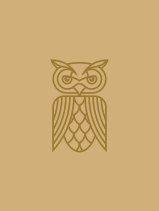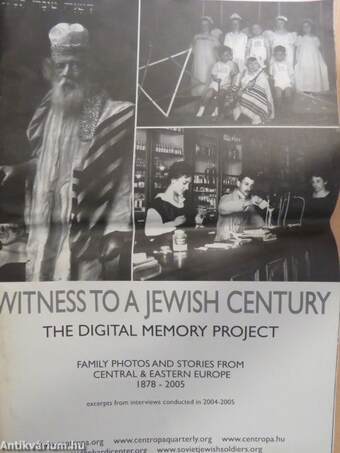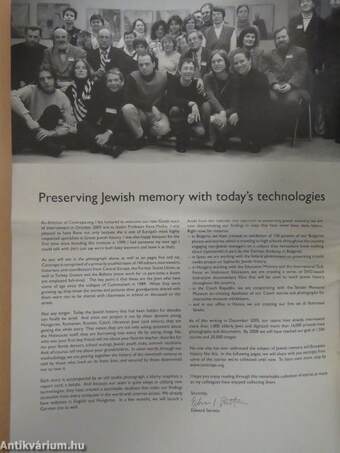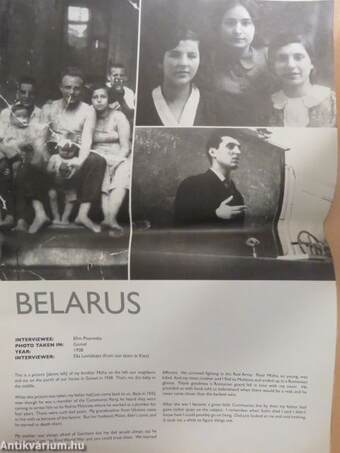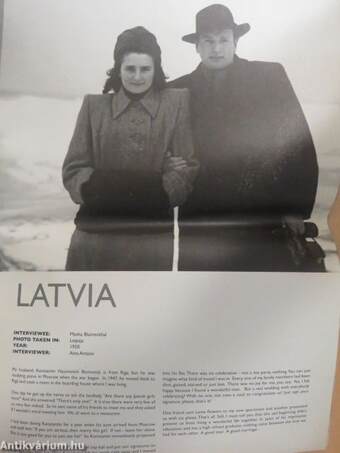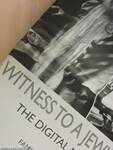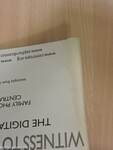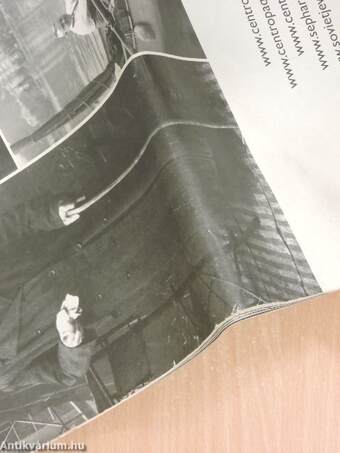1.072.879
kiadvánnyal nyújtjuk Magyarország legnagyobb antikvár könyv-kínálatát

VISSZA
A TETEJÉRE
JAVASLATOKÉszre-
vételek
Witness to a jewish century
The digital memory project/Family photos and stories from Central & Eastern Europe/1878-2005/Excerpts from interviews conducted in 2004-2005
| Kiadó: | The Central Europe Center for Research and Documentation |
|---|---|
| Kiadás helye: | |
| Kiadás éve: | |
| Kötés típusa: | Tűzött kötés |
| Oldalszám: | 40 oldal |
| Sorozatcím: | |
| Kötetszám: | |
| Nyelv: | Angol |
| Méret: | 42 cm x 30 cm |
| ISBN: | |
| Megjegyzés: | Fekete-fehér fotókkal. További kapcsolódó személyek a kötetben. |
naponta értesítjük a beérkező friss
kiadványokról
naponta értesítjük a beérkező friss
kiadványokról
Előszó
Preserving Jewish memory with today's technologies
As director of Centropa.org, I felt honored to welcome our new Greek team of interviewers in October 2005 and its leader, Professor Rena Molho.... Tovább
Előszó
Preserving Jewish memory with today's technologies
As director of Centropa.org, I felt honored to welcome our new Greek team of interviewers in October 2005 and its leader, Professor Rena Molho. I was pleased to have Rena not only because she is one of Europe's most highly respected specialists in Greek Jewish history. I was also happy because, for the first time since founding this institute in 1999,1 had someone my own age I could talk with (let's just say we're both baby boomers and leave it at that).
As you will see in the photograph above, as well as on pages five and six, Centropa is comprised of a primarily youthful team of 140 editors, interviewers, historians and coordinators from Central Europe, the Former Soviet Union, as well as Turkey, Greece and the Balkans (most work for us part-time; a dozen are employed full-time). The key point is that these are the Jews who have come of age since the collapse of Communism in 1989. When they were growing up, they knew the stories and pictures their grandparents shared with them were not to be shared with classmates in school or discussed on the street.
Not any longer. Today, the Jewish history that had been hidden for decades can finally be aired. And since our project is run by these dynamic young Hungarian, Romanian, Russian, Czech, Ukrainian Jews (and others), they are getting the whole story. That means they are not only asking questions about the Holocaust itself, they are burrowing into every life by asking things like: who was your first boy friend; tell me about your favorite teacher; describe for me your family dinners, school outings, Jewish youth clubs, summer vacations. And, of course: tell me about your grandchildren. In other words, through our methodology, we are piecing together the history of the twentieth century as told by those who lived on its front lines, and secured by those determined not to lose it.
Each story is accompanied by an old studio photograph, a blurry snapshot, a report card, a ketuba. And because our team is quite adept in utilizing new technologies, they have created a searchable database that make our findings accessible from every computer in the world with internet access. We already have websites in English and Hungarian. In a few months, we will launch a German site as well.
Aside from this radically new approach to preserving Jewish memory, we are now disseminating our findings in ways that have never been done before. Right now, for instance:
— !n Bulgaria, we have created an exhibition of 150 posters of our Bulgarian photos and stories, which is traveling to high schools throughout the country, engaging non-Jewish teenagers on a subject they heretofore knew nothing about (sponsored, in part, by the German Embassy in Bulgaria),
— in Spain, we are working with the federal government on presenting a multi media project on Sephardic Jewish history,
- in Hungary, working with the Education Ministry and the International Task Force on Holocaust Education, we are creating a series of DVD-based interactive documentary films that will be used to teach Jewish history throughout the country,
- in the Czech Republic, we are cooperating with the Terezin Memorial Museum on creating databases of our Czech stories and photographs for interactive museum exhibitions,
~ and in our office in Vienna, we are creating our first set of illustrated books.
As of this writing in December 2005, our teams have already interviewed more than 1,000 elderly Jews and digitized more than 16,000 privately-held photographs and documents. By 2008 we will have reached our goal of 1,500 stories and 20,000 images.
No one else has ever addressed the subject of Jewish memory and European history like this. In the following pages, we will share with you excerpts from some of the stories we've collected until now. To learn even more, stop by www.centropa.org.
I hope you enjoy reading through this remarkable collection of stories as much as my colleagues have enjoyed collecting them.
Sincerely, Edward Serotta Vissza
Témakörök
- Történelem > Társadalomelmélet
- Szociológia > Szociográfia
- Idegennyelv > Idegennyelvű könyvek > Angol > Művészetek > Fotóművészet
- Idegennyelv > Idegennyelvű könyvek > Angol > Szociológia > Szociográfia
- Idegennyelv > Idegennyelvű könyvek > Angol > Történelem > Európa története > Egyéb
- Művészetek > Fotóművészet > Idegen nyelv > Angol
- Művészetek > Fotóművészet > Témái > Fotódokumentumok
- Művészetek > Fotóművészet > Témái > Portré > Egyéb
- Történelem > Idegennyelvű > Angol
- Történelem > Levelek, forráskiadványok, dokumentumok > XX-XXI. század
- Idegennyelv > Idegennyelvű könyvek > Angol > Szociológia > Társadalmi csoportok > Kisebbségek > Zsidóság
- Szociológia > Társadalmi csoportok > Kisebbségek > Zsidóság > Egyéb
- Történelem > Kontinensek szerint > Európa, európai országok története > Kelet-Európa > Egyéb
- Történelem > Legújabb kor > II. világháború > Holokauszt
- Történelem > Újkor > Egyéb
- Történelem > Kontinensek szerint > Európa, európai országok története > Közép-Európa > Egyéb
- Történelem

